Creating a Shopify store is certainly an exciting venture, but the task of editing it might initially appear daunting. This is where our ‘How to Edit Shopify Websites: A Beginner’s Guide’ comes in. Our guide is designed to unravel the complexities of this process, covering everything from theme adjustments to managing inventory in comprehensive detail.
By the time you finish reading, you’ll find yourself navigating and managing your Shopify site with newfound confidence and proficiency. So, let’s embark on this eCommerce journey together, ensuring you’re well-prepared, thoroughly informed, and ready for success.
Brief overview of Shopify and its importance for eCommerce businesses
Shopify is a comprehensive eCommerce platform that plays a crucial role in the success of online businesses. It offers an all-in-one solution and allows anyone to start, manage, and scale an online store easily. Its significance lies in providing a user-friendly interface, customizable templates, and integrated tools for payment processing, inventory management, and marketing.
Shopify empowers businesses to establish a professional online presence, expand their reach across multiple channels, and seamlessly handle transactions. The importance of Shopify for eCommerce businesses is highlighted by its convenience. It simplifies the process of building and expanding an online store. This makes it a preferred platform for both budding entrepreneurs and established brands.
Importance of editing Shopify website for customization and optimization
Editing a Shopify website holds immense importance for customization and optimization, contributing significantly to the overall success of an online store. Here are reasons highlighting the importance of editing a website in Shopify:
Brand Consistency: Editing allows you to align your website with your brand identity. Consistent branding, including logos, colors, and fonts, fosters recognition and trust among visitors.
User Experience Enhancement: Customization optimizes the user interface, making it intuitive and user-friendly. A well-edited website improves navigation, providing a positive and seamless customer experience.
SEO Optimization: Editing a website enables the incorporation of SEO best practices. Optimized content, meta tags, and URLs improve search engine rankings, driving organic traffic to your site.
Mobile Responsiveness: Customizing your website for mobile devices ensures your online store is accessible and visually appealing across various screen sizes. Mobile-friendly sites improve user engagement and SEO rankings.
Conversion Rate Improvement: Optimized layouts, compelling product displays, and streamlined checkout processes, achieved through editing, enhance the chances of converting visitors into customers.
Personalization Opportunities: Customizing your website allows for personalized content and offers based on user behavior. Tailoring the website to individual preferences increases engagement and customer loyalty.
Recommended Blog for You:
👉 How to Add Sizes on Shopify: A Step-By-Step Guide
👉 How to Publish a Shopify Store: Get Started With Shopify
👉 How to Fulfill Orders on Shopify- The Step-by-Step Guide
👉 How to Make Shopify Store Live- A Complete Walkthrough
👉 How to Organize Products on Shopify – Creating a User-Friendly Shopping Experience
How to Edit Shopify Websites: Modifying Your Theme
Here’s a step-by-step guide on how to Edit Shopify Website:
Choosing a Theme
Choosing a Theme from Shopify Theme Editor: A Step-by-Step Guide
Go to Your Shopify Admin Dashboard: Log in to your Shopify store and navigate to the admin dashboard.

Access Shopify theme editor: Under “Sales Channel” and “Online Store,” select “Themes.”

Visit Theme Store: In the themes section, choose “Visit Theme Store” to explore available themes.
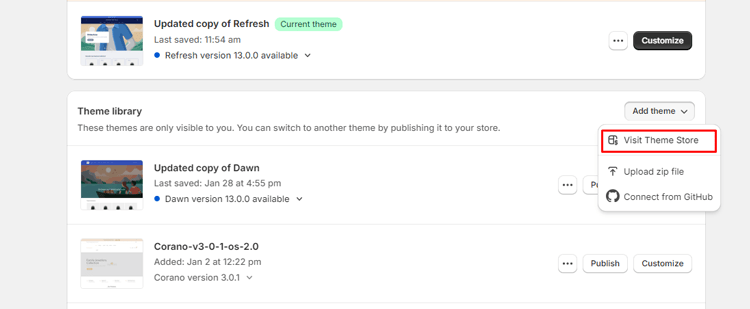
Select Your Desired Theme: Browse through the Shopify theme options and choose the one that aligns with your brand and preferences.
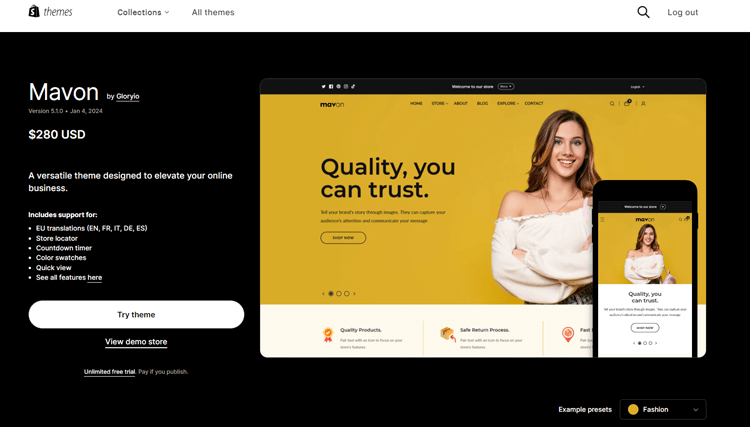
Purchase the Theme: Once you’ve found the desired Shopify theme, select “Buy Theme.”
Approve Payment: Follow the prompts to approve the payment for the selected Shopify theme.

Customizing Your Theme
When customizing your Shopify theme, focus on key design elements influencing user experience: typography, color schemes, imagery, and navigation. Choose readable fonts that resonate with your brand’s identity. Implement a color scheme that evokes the desired emotions. Highlight your products using high-quality images. Guarantee a smooth customer journey with intuitive navigation.
Managing Your Products
Adding Products
Efficiently adding products is the first step to a well-optimized Shopify website. Navigate to your Shopify admin panel, select “Products,” and click “Add product.” Fill in details such as title, description, price, and images. Specify variants and set inventory details. This ensures a comprehensive showcase of your offerings, enhancing your online store’s overall appeal and functionality.
Organizing Your Products
Effective organization is key to a user-friendly and optimized website. Utilize product categories or collections to logically group items. Implement tags and filters for easy navigation. Strategically arrange products on your homepage for visibility. A well-organized product structure enhances the customer experience and contributes to overall website optimization.
Managing Your Inventory
Optimizing your Shopify website includes sharp inventory management. Regularly update product quantities, enable inventory tracking, and set low-stock alerts. Utilize reporting tools to monitor product performance and set up automated reminders for restocking. Effectively managing your inventory ensures a seamless shopping experience for customers and prevents stock-related issues.
Edit Shopify Website’s HomePage
To edit a page in Shopify on your Shopify store, follow these steps:
Step 1: Select Your Theme
Log in to your Shopify store and go to the admin dashboard. Choose the Shopify theme you want to edit. Click on the “Actions” dropdown menu next to the Shopify theme name and select “Customize” to open the Shopify theme editor.
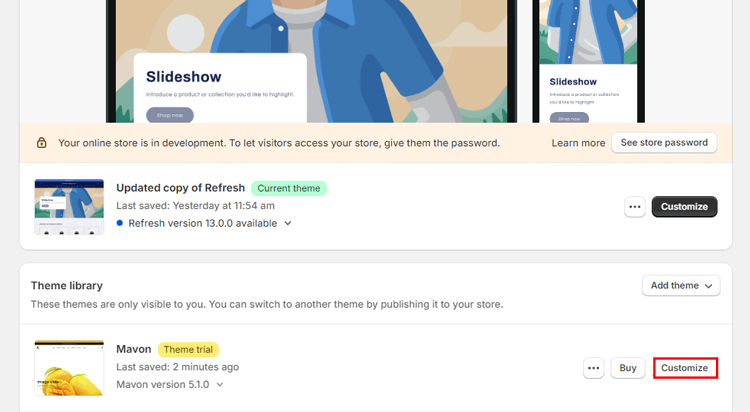
Step 2: Select the Home Page
Once in the home page editor, select the specific page or template representing your home page, often named “Home” or “Index.” Click on the page or template to begin editing.
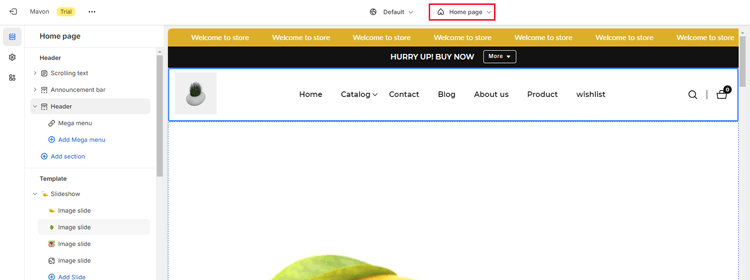
Step 3: Get Informed with the Editing Interface
The editor typically consists of two main sections. The left side displays a menu with customizable sections like header, slideshow, and footer. The right side shows a real-time preview, allowing live edits.
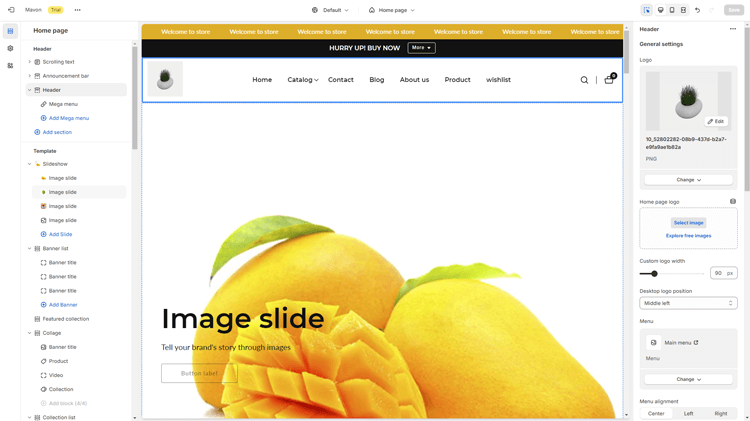
Step 4: Customize the Header
The header is crucial. Modify the logo, navigation menu, and other elements to create a cohesive look. Use consistent brand colors and typefaces.
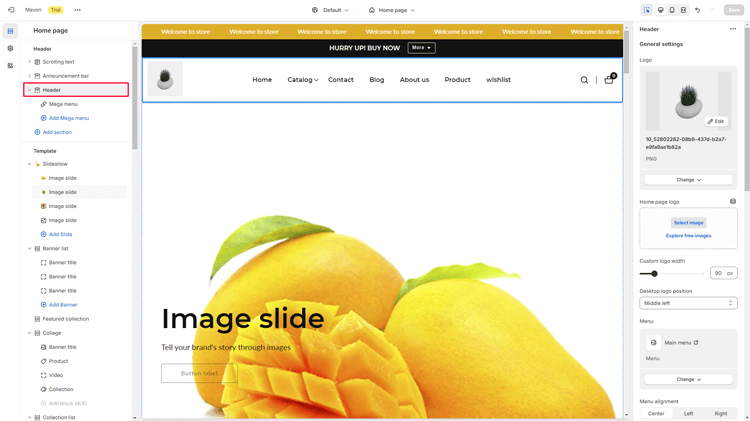
Step 5: Enhance the Slideshow
In the editor, add or remove slides, adjust transition effects, and customize text and images for each slide in the slideshow section. Select eye-catching photos that best convey your brand and draw in customers. These steps empower you to create a captivating and conversion-driven home page on Shopify.
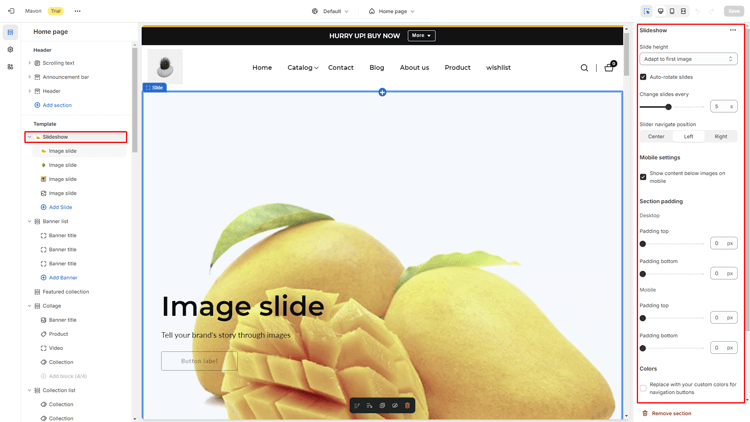
Manage website navigation and search functionality
Managing navigation and search functionality is vital for optimizing your Shopify website. Incorporate essential information browsers require into your header for easy access. Implement a robust eCommerce navigation search bar, allowing users to find products swiftly. Enhance the user experience by adding an ecommerce site-wide benefits bar, highlighting key advantages.
Ensure your navigation structure is intuitive, streamlining the customer journey. Design an eCommerce menu that reflects your brand and yields tangible results. A well-organized, user-friendly navigation system enhances the browsing experience. This encourages customer engagement on your Shopify site. Ultimately, it leads to boosted conversions and increased sales.
Grow Your eCommerce Business with Valuable Resources, Tools, and Lead Magnets
- Bring your ideas to life for $1/month
- One platform that lets you sell wherever your customers are—online
- Create a beautiful eCommerce website
- Start for free, then enjoy $1/month for 3 months
- Build your own website in a few steps
- Create a website in minutes easily, secure method
- Turn what you love into what you sell
- Discover the Shopify Point of Sale
- AI Based Business Name Generator
Optimizing Your Website
Search Engine Optimization (SEO)
Search Engine Optimization (SEO) is paramount for driving traffic and sales to your website. With Shopify’s built-in tools, optimizing your site for search engines becomes accessible and effective. From keyword optimization to meta tags and sitemaps, Shopify provides comprehensive features to enhance your site’s visibility.
Recognizing the importance of SEO ensures that your online presence is attractive to users and ranks favorably on search engine result pages, ultimately boosting your website’s reach and impact.
Website Performance
The speed and performance of your Shopify website are crucial for both user experience and SEO. A fast-loading website enhances user satisfaction and positively influences search engine rankings. Shopify offers tools and best practices to optimize your website’s speed, including image optimization, responsive design, and efficient coding.
By prioritizing website performance, you create a seamless and enjoyable browsing experience for visitors and align with search engine algorithms, resulting in improved visibility and overall success.
Frequently Asked Questions
What can I customize on my Shopify website?
You can customize various elements, including colors, fonts, images, and layouts. Additionally, you can edit the header, footer, and homepage to create a unique online presence.
How can I update my Shopify store with new products?
To add products, go to “Products” in your admin dashboard, click “Add product,” and fill in details like title, description, price, and images. Organize products into collections for better navigation.
How can I optimize my Shopify website for SEO?
Utilize Shopify’s built-in SEO tools by optimizing product titles, descriptions, and meta tags. Create a sitemap, use descriptive URLs, and regularly update content for better search engine rankings.
What is the importance of website performance optimization?
Optimizing website performance ensures fast loading times, contributing to a positive user experience. Use Shopify’s tools and follow best practices to enhance site speed and overall performance.
Can I change my website’s navigation and search functionality?
Yes, you can. Most website platforms, including Shopify, offer customization options that allow you to modify your site’s navigation and search functionality. It includes changes to your header information, implementation of an eCommerce search bar, and design of a user-friendly menu.
Hire Experts to Build Your Shopify Store [Recommended- ShopiBuffet]
ShopiBuffet is an excellent choice for anyone looking to improve their Shopify stores. This eCommerce expertise employs a complete strategy that frees people and companies to concentrate on expansion while leaving the finer points of technology to their team of seasoned professionals. ShopiBuffet’s user-friendly Shopify storefront, backed by an experienced design and marketing staff that can accommodate different budgets, is what makes it so appealing.

The quick-thinking ShopiBuffet staff is devoted to fulfilling client needs immediately, demonstrating their everlasting commitment to client pleasure. ShopiBuffet is the best option when you start building a successful Shopify store, opening the door for your success.
What Services We Offer:
- Theme Installation & Demo Setup
- Product & Collection Setup
- Navigation Setup
- Shopify SEO Services
- Shopify migration service
- Shopify stores regular updates and maintenance service
Conclusion
Are you worried about how to edit Shopify website? Don’t worry. Editing a Shopify website is an easy task that requires attention to detail and patience. Follow the instructions mentioned above on how to edit Shopify website.
As you continue to work on your Shopify website, you’ll get better at it. Practice helps you improve, so don’t be afraid to try new things and learn about the platform. Soon, you’ll be able to easily modify your Shopify website to fit what you want.




